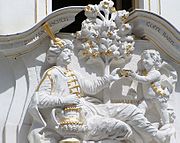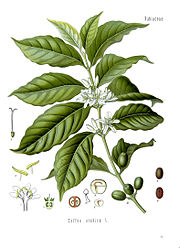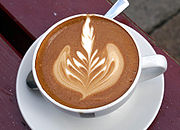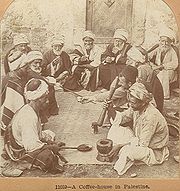
Coffee
About this schools Wikipedia selection
This Schools selection was originally chosen by SOS Children for schools in the developing world without internet access. It is available as a intranet download. A quick link for child sponsorship is http://www.sponsor-a-child.org.uk/
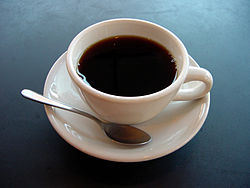 |
|
| Type | Hot Beverage |
|---|---|
| Manufacturer | Varied |
| Country of origin | Ethiopia |
| Introduced | (around) 800 AD |
| Colour | Dark Brown / Light Brown |
Coffee is a widely-consumed stimulant beverage prepared from roasted seeds, commonly called coffee beans, of the coffee plant. Coffee was first consumed in the 9th century, when it was discovered in the highlands of Ethiopia. From there, it spread to Egypt and Yemen, and by the 15th century had reached Armenia, Persia, Turkey, and northern Africa. From the Muslim world, coffee spread to Italy, then to the rest of Europe and the Americas. Today, coffee is one of the most popular beverages worldwide.
Coffee berries, which contain the coffee bean, are produced by several species of small evergreen bush of the genus Coffea. The two most commonly grown species are Coffea canephora (also known as Coffea robusta) and Coffea arabica. These are cultivated in Latin America, Southeast Asia, and Africa. Once ripe, coffee berries are picked, processed, and dried. The seeds are then roasted, undergoing several physical and chemical changes. They are roasted to varying degrees, depending on the desired flavor. They are then ground and brewed to create coffee. Coffee can be prepared and presented in a variety of ways.
Coffee has played an important role in many societies throughout modern history. In Africa and Yemen, it was used in religious ceremonies. As a result, the Ethiopian Church banned its consumption until the reign of Emperor Menelik II of Ethiopia. It was banned in Ottoman Turkey in the 17th century for political reasons, and was associated with rebellious political activities in Europe.
Coffee is an important-export commodity. In 2004, coffee was the top agricultural export for 12 countries, and in 2005, it was the world's seventh largest legal agricultural export by value.
Some controversy is associated with coffee cultivation and its impact on the environment. Many studies have examined the relationship between coffee consumption and certain medical conditions; whether the effects of coffee are positive or negative is still disputed..
Etymology
The English word coffee first came to be used in the early- to mid-1600s, but early forms of the word date to the last decade of the 1500s. It comes from the Italian caffè. The term was introduced to Europe via the Ottoman Turkish kahve which is in turn derived from the Arabic: قهوة, qahweh. The origin of the Arabic term is uncertain; it is either derived from the name of the Kaffa region in western Ethiopia, where coffee was cultivated, or by a truncation of qahwat al-būnn, meaning "wine of the bean" in Arabic. In Eritrea, "būnn" (also meaning "wine of the bean" in Tigrinya) is used. The Amharic and Afan Oromo name for coffee is bunna.
History
Coffee use can be traced at least to as early as the 9th century, when it appeared in the highlands of Ethiopia. According to legend, Ethiopian shepherds were the first to observe the influence of the caffeine in coffee beans when the goats appeared to "dance" and to have an increased level of energy after consuming wild coffee berries. The legend names the shepherd "Kaldi." From Ethiopia, coffee spread to Egypt and Yemen. It was in Arabia that coffee beans were first roasted and brewed similarly as they are today. By the 15th century, it had reached the rest of the Middle East, Persia, Turkey, and northern Africa.
In 1583, Leonhard Rauwolf, a German physician, gave this description of coffee after returning from a ten year trip to the Near East:
| “ | A beverage as black as ink, useful against numerous illnesses, particularly those of the stomach. Its consumers take it in the morning, quite frankly, in a porcelain cup that is passed around and from which each one drinks a cupful. It is composed of water and the fruit from a bush called bunnu. | ” |
From the Muslim world, coffee spread to Italy. The thriving trade between Venice and North Africa, Egypt, and the Middle East brought many goods, including coffee, to the Venetian port. From Venice, it was introduced to the rest of Europe. Coffee became more widely accepted after it was deemed a Christian beverage by Pope Clement VIII in 1600, despite appeals to ban the "Muslim drink". The first European coffee house opened in Italy in 1645. The Dutch were the first to import coffee on a large scale, and they were among the first to defy the Arab prohibition on the exportation of plants or unroasted seeds when Pieter van den Broeck smuggled seedlings from Aden into Europe in 1616. The Dutch later grew the crop in Java and Ceylon. Through the efforts of the British East India Company, coffee became popular in England as well. It was introduced in France in 1657, and in Austria and Poland after the 1683 Battle of Vienna, when coffee was captured from supplies of the defeated Turks.
When coffee reached North America during the colonial period, it was initially not as successful as it had been in Europe. During the Revolutionary War, however, the demand for coffee increased so much that dealers had to hoard their scarce supplies and raise prices dramatically; this was partly due to the reduced availability of tea from British merchants. After the War of 1812, during which Britain temporarily cut off access to tea imports, the Americans' taste for coffee grew, and high demand during the American Civil War together with advances in brewing technology secured the position of coffee as an everyday commodity in the United States.
Noted as one of the world’s largest, most valuable, legally traded commodities after oil, coffee has become a vital cash crop for many Third World countries. Over one hundred million people in developing countries have become dependent on coffee as the primary source of income (Ponte 1). Coffee has become the primary export and backbone for African countries like Uganda, Burundi, Rwanda, and Ethiopia as well as other Central American countries (1)
Biology
The Coffea plant is native to subtropical Africa and southern Asia. It belongs to a genus of 10 species of flowering plants of the family Rubiaceae. It is an evergreen shrub or small tree that may grow 5 meters (16 ft) tall when unpruned. The leaves are dark green and glossy, usually 10–15 centimeters (3.9–5.9 in) long and 6.0 centimeters (2.4 in) wide. It produces clusters of fragrant, white flowers that bloom simultaneously. The fruit berry is oval, about 1.5 centimeters (0.6 in) long, and green when immature, but ripens to yellow, then crimson, becoming black on drying. Each berry usually contains two seeds, but from 5 to 10 percent of the berries have only one; these are called peaberries. Berries ripen in seven to nine months.
Cultivation
Coffee is usually propagated by seeds. The traditional method of planting coffee is to put 20 seeds in each hole at the beginning of the rainy season; half are eliminated naturally. Coffee is often intercropped with food crops, such as corn, beans, or rice, during the first few years of cultivation.
The two main cultivated species of the coffee plant are Coffea canephora and Coffea arabica. Arabica coffee (from C. arabica) is considered more suitable for drinking than robusta coffee (from C. canephora); robusta tends to be bitter and have less flavor than arabica. For this reason, about three-quarters of coffee cultivated worldwide is C. arabica. However, C. canephora is less susceptible to disease than C. arabica and can be cultivated in environments where C. arabica will not thrive. Robusta coffee also contains about 40–50 percent more caffeine than arabica. For this reason, it is used as an inexpensive substitute for arabica in many commercial coffee blends. Good quality robustas are used in some espresso blends to provide a better foam head and to lower the ingredient cost. Other cultivated species include Coffea liberica and Coffea esliaca, believed to be indigenous to Liberia and southern Sudan, respectively.
Most arabica coffee beans originate from either Latin America, eastern Africa, Arabia, or Asia. Robusta coffee beans are grown in western and central Africa, throughout southeast Asia, and to some extent in Brazil. Beans from different countries or regions usually have distinctive characteristics such as flavor, aroma, body, and acidity. These taste characteristics are dependent not only on the coffee's growing region, but also on genetic subspecies ( varietals) and processing. Varietals are generally known by the region in which they are grown, such as Colombian, Java, or Kona.
Production
Brazil is world leader in production of green coffee followed by Vietnam, Indonesia, Colombia and Mexico.
| Top Ten Green Coffee Producers — 2005 | ||||
|---|---|---|---|---|
| Country | Production (Int $1000) | Footnote | Production (MT) | Footnote |
| 1,781,684 | C | 2,179,270 | ||
| 809,384 | C | 990,000 | * | |
| 622,986 | C | 762,006 | ||
| 558,050 | C | 682,580 | ||
| 254,148 | C | 310,861 | F | |
| 224,829 | C | 275,000 | ||
| 212,566 | C | 260,000 | F | |
| 177,084 | C | 216,600 | F | |
| 155,860 | C | 190,640 | ||
| 152,066 | C | 186,000 | F | |
| No symbol = official figure,F = FAO estimate, * = Unofficial figure, C = Calculated figure; Production in Int $1000 have been calculated based on 1999-2001 international prices |
||||
Ecological effects
Originally, coffee farming was done in the shade of trees, which provided habitat for many animals and insects. This method is commonly referred to as the traditional shaded method. Many farmers (but not all) have decided to modernize their production methods and switch to a method where farmers would now use sun cultivation, in which coffee is grown in rows under full sun with little or no forest canopy. This causes berries to ripen more rapidly and bushes to produce higher yields but requires the clearing of trees and increased use of fertilizer and pesticides. Traditional coffee production, on the other hand, caused berries to ripen more slowly and it produced lower yields compared to the modernized method but the quality of the coffee is allegedly superior. In addition, the traditional shaded method is environmentally friendly and serves as a habitat for many species. Opponents of sun cultivation say environmental problems such as deforestation, pesticide pollution, habitat destruction, and soil and water degradation are the side effects of these practices. The American Birding Association has led a campaign for "shade-grown" and organic coffees, which it says are sustainably harvested. However, while certain types of shaded coffee cultivation systems show greater biodiversity than full-sun systems, they still compare poorly to native forest in terms of habitat value.
Economics
Brazil remains the largest coffee exporting nation, but in recent years Vietnam has become a major producer of robusta beans. Colombia is the third exporter and the largest producer of washed arabica coffee. Robusta coffees, traded in London at much lower prices than New York's arabica, are preferred by large industrial clients, such as multinational roasters and instant coffee producers, because of the lower cost. Four single roaster companies buy more than 50 percent of all of the annual production: Kraft, Nestlé, Procter & Gamble, and Sara Lee. The preference of the "Big Four" coffee companies for cheap robusta is believed by many to have been a major contributing factor to the crash in coffee prices, and the demand for high-quality arabica beans is only slowly recovering.
Many experts believe the giant influx of cheap green coffee after the collapse of the International Coffee Agreement of 1975–1989 led to the prolonged price crisis from 1989 to 2004. In 1997 the price of coffee in New York broke US$3.00/ lb, but by late 2001 it had fallen to US$0.43/lb. In 2007, wholesale coffee was about US$1/lb (e.g. 69 cents in London in March to 134 cents in New York in October), with robusta being about 70% of the price of arabica. Retail prices varied from an average of $3 in Poland to $3.50 in the US to $17 in the UK.
The concept of fair trade labeling, which guarantees coffee growers a negotiated pre-harvest price, began with the Max Havelaar Foundation's labelling program in the Netherlands. In 2004, 24,222 metric tons out of 7,050,000 produced worldwide were fair trade; in 2005, 33,991 metric tons out of 6,685,000 were fair trade, an increase from 0.34 percent to 0.51 percent. A number of studies have shown that fair trade coffee has a positive impact on the communities that grow it. A study in 2002 found that fair trade strengthened producer organizations, improved returns to small producers, and positively affected their quality of life. A 2003 study concluded that fair trade has "greatly improved the well-being of small-scale coffee farmers and their families" by providing access to credit and external development funding and greater access to training, giving them the ability to improve the quality of their coffee. The families of fair trade producers were also more stable than those who were not involved in fair trade, and their children had better access to education. A 2005 study of Bolivian coffee producers concluded that Fairtrade certification has had a positive impact on local coffee prices, economically benefiting all coffee producers, Fairtrade certified or not.
The production and consumption of "Fair Trade Coffee" has grown in recent years as some local and national coffee chains have started to offer fair trade alternatives.
Processing
Roasting
Coffee berries and their seeds undergo several processes before they become the familiar roasted coffee. First, coffee berries are picked, generally by hand. Then, they are sorted by ripeness and colour and the flesh of the berry is removed, usually by machine, and the seeds—usually called beans—are fermented to remove the slimy layer of mucilage still present on the bean. When the fermentation is finished, the beans are washed with large quantities of fresh water to remove the fermentation residue, which generates massive amounts of highly polluted coffee wastewater. Finally the seeds are dried, sorted, and labeled as green coffee beans.
The next step in the process is the roasting of the green coffee. Coffee is usually sold in a roasted state, and all coffee is roasted before it is consumed. It can be sold roasted by the supplier, or it can be home roasted. The roasting process influences the taste of the beverage by changing the coffee bean both physically and chemically. The bean decreases in weight as moisture is lost and increases in volume, causing it to become less dense. The density of the bean also influences the strength of the coffee and requirements for packaging. The actual roasting begins when the temperature inside the bean reaches 200 °C (392 ° F), though different varieties of beans differ in moisture and density and therefore roast at different rates. During roasting, caramelization occurs as intense heat breaks down starches in the bean, changing them to simple sugars that begin to brown, changing the colour of the bean. Sucrose is rapidly lost during the roasting process and may disappear entirely in darker roasts. During roasting, aromatic oils, acids, and caffeine weaken, changing the flavor; at 205 °C (400 °F), other oils start to develop. One of these oils is caffeol, created at about 200 °C (392 °F), which is largely responsible for coffee's aroma and flavor.
Depending on the colour of the roasted beans as perceived by the human eye, they will be labeled as light, medium-light, medium, medium-dark, dark, or very dark. A more accurate method of discerning the degree of roast involves measuring the reflected light from roasted beans illuminated with a light source in the near infrared spectrum. This elaborate light meter uses a process known as Spectroscopy to return a number that consistently indicates the roasted coffee’s relative degree of roast or flavor development. Such devices are routinely used for quality assurance by coffee roasting businesses.
Darker roasts are generally smoother, because they have less fibre content and a more sugary flavor. Lighter roasts have more caffeine, resulting in a slight bitterness, and a stronger flavor from aromatic oils and acids otherwise destroyed by longer roasting times. A small amount of chaff is produced during roasting from the skin left on the bean after processing. Chaff is usually removed from the beans by air movement, though a small amount is added to dark roast coffees to soak up oils on the beans. Decaffeination may also be part of the processing that coffee seeds undergo. Seeds are decaffeinated when they are still green. Many methods can remove caffeine from coffee, but all involve either soaking beans in hot water or steaming them, then using a solvent to dissolve caffeine-containing oils. Decaffeination is often done by processing companies, and the extracted caffeine is usually sold to the pharmaceutical industry.
Storage
Once roasted, coffee beans must be stored properly to preserve the fresh taste of the bean. Ideal conditions are air-tight and cool. Air, moisture, heat and light are the environmental factors in order of importance to preserving flavor in coffee beans.
Folded-over bags, a common way consumers often purchase coffee, is generally not ideal for long-term storage because it allows air to enter. A better package contains a one-way valve, which prevents air from entering.
Preparation
Coffee beans must be ground and brewed in order to create a beverage. Grinding the roasted coffee beans is done at a roastery, in a grocery store, or in the home. They are most commonly ground at a roastery then packaged and sold to the consumer, though "whole bean" coffee can be ground at home. Coffee beans may be ground in several ways. A burr mill uses revolving elements to shear the bean, an electric grinder smashes the beans with blunt blades moving at high speed, and a mortar and pestle crushes the beans.
The type of grind is often named after the brewing method for which it is generally used. Turkish grind is the finest grind, while coffee percolator or French press are the coarsest grind. The most common grinds are between the extremes; a medium grind is used in most common home coffee brewing machines.
Coffee may be brewed by several methods: boiled, steeped, or pressured. Brewing coffee by boiling was the earliest method, and Turkish coffee is an example of this method. It is prepared by powdering the beans with a mortar and pestle, then adding the powder to water and bringing it to a boil in a pot called a cezve or, in Greek, a briki. This produces a strong coffee with a layer of foam on the surface.
Machines such as percolators or automatic coffeemakers brew coffee by gravity. In an automatic coffeemaker, hot water drips onto coffee grounds held in a coffee filter made of paper or perforated metal, allowing the water to seep through the ground coffee while absorbing its oils and essences. Gravity causes the liquid to pass into a carafe or pot while the used coffee grounds are retained in the filter. In a percolator, boiling water is forced into a chamber above a filter by pressure created by boiling. The water then passes downwards through the grounds due to gravity, repeating the process until shut off by an internal timer.
Coffee may also be brewed by steeping in a device such as a French press (also known as a cafetière). Ground coffee and hot water are combined in a coffee press and left to brew for a few minutes. A plunger is then depressed to separate the coffee grounds, which remain at the bottom of the container. Because the coffee grounds are in direct contact with the water, all the coffee oils remain in the beverage, making it stronger and leaving more sediment than in coffee made by an automatic coffee machine.
The espresso method forces hot, but not boiling, pressurized water through ground coffee. As a result of brewing under high pressure (ideally between 9-10 atm) the espresso beverage is more concentrated (as much as 10 to 15 times the amount of coffee to water as gravity brewing methods can produce) and has a more complex physical and chemical constitution. A well prepared espresso has a reddish-brown foam called crema that floats on the surface. The drink " Americano" is popularly thought to have been named after American soldiers in WW II who found the European way of drinking espresso too strong. Baristas would cut the espresso with hot water for them.
Presentation
Once brewed, coffee may be presented in a variety of ways. Drip brewed, percolated, or French-pressed/cafetière coffee may be served with no additives (colloquially known as black) or with either sugar, milk or cream, or both. When served cold, it is called iced coffee.
Espresso-based coffee has a wide variety of possible presentations. In its most basic form, it is served alone as a "shot" or in the more watered down style café américano—a shot or two of espresso with hot water. The Americano should be served with the espresso shots on top of the hot water to preserve the crema. Milk can be added in various forms to espresso: steamed milk makes a cafè latte, equal parts espresso and milk froth make a cappuccino, and a dollop of hot, foamed milk on top creates a caffè macchiato.
A number of products are sold for the convenience of consumers who do not want to prepare their own coffee. Instant coffee is dried into soluble powder or freeze dried into granules that can be quickly dissolved in hot water. Canned coffee has been popular in Asian countries for many years, particularly in Japan and South Korea. Vending machines typically sell varieties of flavored canned coffee, much like brewed or percolated coffee, available both hot and cold. Japanese convenience stores and groceries also have a wide availability of bottled coffee drinks, which are typically lightly sweetened and pre-blended with milk. Bottled coffee drinks are also consumed in the United States. Liquid coffee concentrates are sometimes used in large institutional situations where coffee needs to be produced for thousands of people at the same time. It is described as having a flavor about as good as low-grade robusta coffee and costs about 10 cents a cup to produce. The machines used can process up to 500 cups an hour, or 1,000 if the water is preheated.
Social aspects
Coffee was initially used for spiritual reasons. At least 1,000 years ago, traders brought coffee across the Red Sea into Arabia (modern day Yemen), where Muslim monks began cultivating the shrub in their gardens. At first, the Arabians made wine from the pulp of the fermented coffee berries. This beverage was known as qishr (kisher in modern usage) and was used during religious ceremonies.
Coffee became the substitute beverage in place of wine in spiritual practices where wine was forbidden. Coffee drinking was briefly prohibited to Muslims as haraam in the early years of the 16th century, but this was quickly overturned. Use in religious rites among the Sufi branch of Islam led to coffee's being put on trial in Mecca: it was accused of being a heretic substance, and its production and consumption were briefly repressed. It was later prohibited in Ottoman Turkey under an edict by the Sultan Murad IV. Coffee, regarded as a Muslim drink, was prohibited to Ethiopian Orthodox Christians until as late as 1889; it is now considered a national drink of Ethiopia for people of all faiths. Its early association in Europe with rebellious political activities led to its banning in England, among other places.
A contemporary example of coffee prohibition can be found in The Church of Jesus Christ of Latter-day Saints. The organization claims that it is both physically and spiritually unhealthy to consume coffee. This comes from the Mormon doctrine of health, given in 1833 by Mormon founder Joseph Smith, in a revelation called the Word of Wisdom. It does not identify coffee by name, but includes the statement that "hot drinks are not for the belly", which has been interpreted to forbid both coffee and tea.
Health and pharmacology
Coffee ingestion on average is about a third of that of tap water in North America and Europe. Worldwide, 6.7 million metric tons of coffee were produced annually in 1998–2000, and the forecast is a rise to 7 million metric tons annually by 2010.
Scientific studies have examined the relationship between coffee consumption and an array of medical conditions. Findings are contradictory as to whether coffee has any specific health benefits, and results are similarly conflicting regarding negative effects of coffee consumption.
Coffee appears to reduce the risk of Alzheimer's disease, Parkinson's disease, heart disease, diabetes mellitus type 2, cirrhosis of the liver, and gout, but it increases the risk of acid reflux and associated diseases. Some health effects of coffee are due to its caffeine content, as the benefits are only observed in those who drink caffeinated coffee, while others appear to be due to other components. For example, the antioxidants in coffee prevent free radicals from causing cell damage.
Coffee's negative health effects are mostly due to its caffeine content. Research suggests that drinking caffeinated coffee can cause a temporary increase in the stiffening of arterial walls. Excess coffee consumption may lead to a magnesium deficiency or hypomagnesaemia, and may be a risk factor for coronary heart disease. Some studies suggest that it may have a mixed effect on short-term memory, by improving it when the information to be recalled is related to the current train of thought, but making it more difficult to recall unrelated information. About 10% of people with a moderate daily intake (235 mg per day) reported increased depression and anxiety when caffeine was withdrawn, and about 15% of the general population report having stopped caffeine use completely, citing concern about health and unpleasant side effects. Nevertheless, the mainstream view of medical experts is that drinking three 8-ounce (236 ml) cups of coffee per day (considered average or moderate consumption) does not have significant health risks for adults.
American scientist Yaser Dorri has suggested that the smell of coffee can restore appetite and refresh olfactory receptors. He suggests that people can regain their appetite after cooking by smelling coffee beans, and that this method might also be used for research animals.
Coffee enemas may have properties which may help cancer patients.
Caffeine content
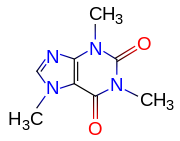
Depending on the type of coffee and method of preparation, the caffeine content of a single serving can vary greatly. On average, a single cup of coffee of about 207 milliliters (7 fluid ounces) or a single shot of espresso of about 30 mL (1oz) can be expected to contain the following amounts of caffeine:
- Drip coffee: 115–175 mg (0.56–0.85 mg/ml)
- Espresso: 60 mg (2 mg/ml)
- Brewed/Pressed: 80–135 mg (0.39–0.65 mg/ml)
- Instant: 65–100 mg (0.31–0.48 mg/ml)
- Decaf, brewed: 3–4 mg
- Decaf, instant: 2–3 mg
